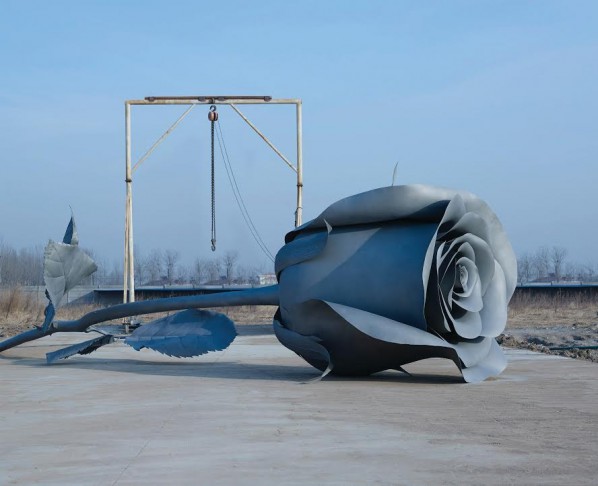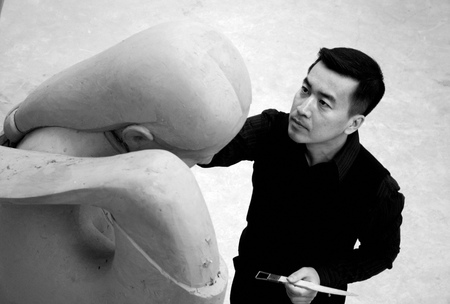
Cai Zhisong, Lying Rose, 2003; cast stainless steel, 250x250x800cm Courtesy of Cai Zhisong
“To represent history” is perhaps a privilege unique to this era. On the one hand, the title evokes an image of us waving at history, welcoming it cautiously as it comes into contact with us again; on the other, the title that is a double entendre also bids farewell to history, expecting to part ways with it. The underlying paradox in the title not only reveals the ambivalence of language but also points out that the reality of history does indeed harbor these two diverging paths. The only way to decide what the two positions truly mean to people is contingent upon us the viewers, in our observation and imagining of the past and the future, as we embark upon the journey from the here and now.
In the realm of artistic creation, many other artists have been considering a similar question: at the crossroads of history, where will we position ourselves, or be positioned? Working at the ending point of history, or perhaps temporarily suspending history altogether, Cai Zhisong constructs an observation deck on which to consider the above question via a series of artworks. He brings together references of works and cultural discourses from different times, allowing them to clash and interact, so that those of us experiencing his creation may begin a long conversation with it. The process of the encounter is full of mystery, as though trying to solve a beautiful, flourishing puzzle.
As a classically trained sculptor, Cai marries his idiosyncratic style to a complex postmodernist vocabulary with the intention of reflecting upon and emphasizing a cultural subject matter: amongst the different aesthetics of the past and the present, of the east and the west, who is in the lead? And who is following behind? From the artist’s solo exhibition at MOCA, Taipei, it is not difficult to see various elements in dialogue and dialectical contexts. Aside from revealing the artist’s ambitious attempt to go a few rounds with history itself, the exhibition also re-focuses our attention towards artistic discussions about subjective thinking and linguistic construct.

Born in Shenyang city, China in 1972, Cai Zhisong earned an BFA (1997) and MFA (2001) in sculpture from the China Central Academy of Fine Arts (CAFA). During 1998 to 2008, he had taught at the Sculpture Department. He now lives and works in Beijing.
Cai is one of the most iconic figures in the Chinese sculpture scene. A young, successful sculptor with ample visibility, he is also a pioneer amongst his generation of Chinese artists in crossing the boundary between contemporary art and fashion. With a thorough classical training in sculpture, Cai’s early pieces, “Summer” and “Monsoon” were collected by the CAFA Art Museum and won the Matsuoka Family Foundation Art Award. In 2001, Cai became the first Chinese artist to be awarded the Taylor Prize at the Salon d’Automne in Paris in over a century. In 2004, he received the Dean’s Award from CAFA, and won bronze medal at the 10th National Art Exhibition in China. In 2011, he represented China in the 54th Venice Biennale. In 2013, his excellence and achievement in the art form of sculpture won him a place in the French magazine Art Actuel’s list of “Top 100 Contemporary Artists.” Ever since his debut in 1998, Cai has participated in various domestic and international group exhibitions, and has had numerous solo exhibitions in Beijing, Shanghai, New York, Singapore and Berlin since 2002. His works of different periods can be seen amongst the collections of arts organizations such as the Rockefeller Foundation, the Greek National Art Gallery, and the Museum of Regensburg in Germany.
Over the years, the main focus of Cai’s oeuvre has been the examination of and reflection upon the human condition. According to his artist, his own experiences of living and growing up forced him to consider the issues of human nature, culture and history. Artist Li Xiangqun once said that he “borrows freely from eastern and western classical traditions; his work is saturated with something which expresses the abstract with the concrete. It transcends traditional figural art and aims for a generalized, unified image, expressing the life of the contemporary man through the very essence of being human. has All of which give his work profound meanings.” Art critic and curator Jia Fangzhou said of Cai’s works thus: “these seemingly figural objects are no longer of their original existence; they have been conceptualized and immortalized as cultural symbols through the transformation of the material.”
About the exhibition
Dates: 25 Jan - 6 Apr, 2014
Venue: MOCA Taipei
Courtesy of the artist and MOCA Taipei, for further information please visit www.mocataipei.org.tw.




























